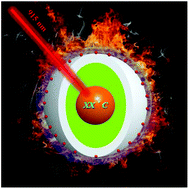Upconversion nanoparticles modified by Cu2S for photothermal therapy along with real-time optical thermometry†
Abstract
Highly effective photothermal conversion performance coupled with high resolution temperature detection in real time is urgently needed for photothermal therapy (PTT). Herein, ultra-small Cu2S nanoparticles (NPs) were designed to absorb on the surface of NaScF4: Yb3+/Er3+/Mn2+@NaScF4@SiO2 NPs to form a central-satellite system, in which the Cu2S NPs play the role of providing significant light-to-heat conversion ability and the Er3+ ions in the NaScF4: Yb3+/Er3+/Mn2+ cores act as a thermometric probe based on the fluorescence intensity ratio (FIR) technology operating in the biological windows. A wavelength of 915 nm is used instead of the conventional 980 nm excitation wavelength to eliminate the laser induced overheating effect for the bio-tissues, by which Yb3+ can also be effectively excited. The temperature resolution of the FIR-based optical thermometer is determined to be better than 0.08 K over the biophysical temperature range with a minimal value of 0.06 K at 298 K, perfectly satisfying the requirements of biomedicine. Under the radiation of 915 nm light, the Cu2S NPs exhibit remarkable light-to-heat conversion capacity, which is proved by photothermal ablation testing of E. coli. The results reveal the enormous potential of the present NPs for PTT integrated with real-time temperature sensing with high resolution.

- This article is part of the themed collection: Editor’s Choice Collection: Photon Upconversion


 Please wait while we load your content...
Please wait while we load your content...